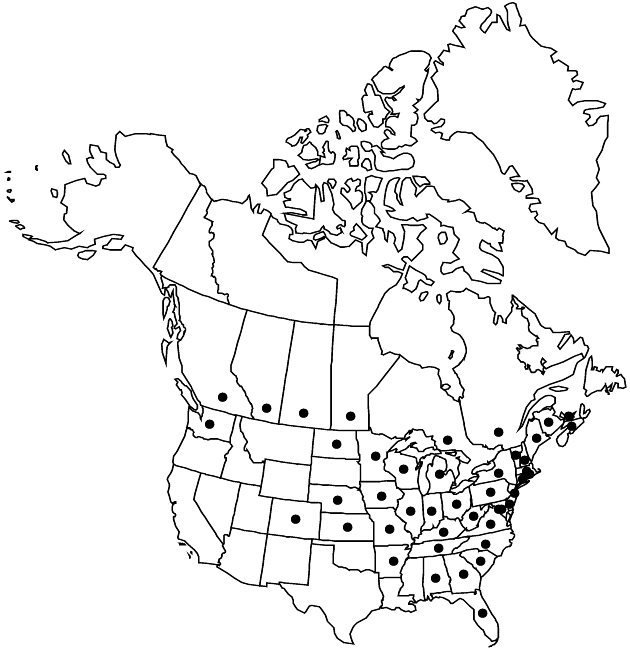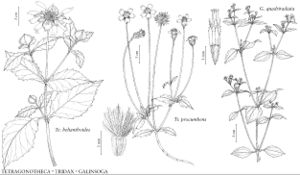Difference between revisions of "Galinsoga quadriradiata"
Syst. Veg. Fl. Peruv. Chil. 1: 198. 1798.
FNA>Volume Importer |
FNA>Volume Importer |
||
| Line 11: | Line 11: | ||
|name=Galinsoga bicolorata | |name=Galinsoga bicolorata | ||
|authority=H. St. John & D. White | |authority=H. St. John & D. White | ||
| − | }}{{Treatment/ID/Synonym | + | }} {{Treatment/ID/Synonym |
|name=Galinsoga caracasana | |name=Galinsoga caracasana | ||
|authority=(de Candolle) Schultz-Bipontinus | |authority=(de Candolle) Schultz-Bipontinus | ||
| − | }}{{Treatment/ID/Synonym | + | }} {{Treatment/ID/Synonym |
|name=Galinsoga ciliata | |name=Galinsoga ciliata | ||
|authority=(Rafinesque) S. F. Blake | |authority=(Rafinesque) S. F. Blake | ||
| Line 32: | Line 32: | ||
|elevation=0–2500 m | |elevation=0–2500 m | ||
|distribution=Alta.;B.C.;Man.;N.B.;N.S.;Ont.;P.E.I.;Que.;Sask.;Ala.;Ark.;Colo.;Conn.;Del.;D.C.;Fla.;Ga.;Ill.;Ind.;Iowa;Kans.;Ky.;Maine;Md.;Mass.;Mich.;Minn.;Mo.;Nebr.;N.H.;N.J.;N.Y.;N.C.;N.Dak.;Ohio;Pa.;R.I.;S.C.;Tenn.;Vt.;Va.;Wash.;W.Va.;Wis.;Mexico;West Indies;Central America;South America;introduced in Europe;Asia;Africa;Pacific Islands. | |distribution=Alta.;B.C.;Man.;N.B.;N.S.;Ont.;P.E.I.;Que.;Sask.;Ala.;Ark.;Colo.;Conn.;Del.;D.C.;Fla.;Ga.;Ill.;Ind.;Iowa;Kans.;Ky.;Maine;Md.;Mass.;Mich.;Minn.;Mo.;Nebr.;N.H.;N.J.;N.Y.;N.C.;N.Dak.;Ohio;Pa.;R.I.;S.C.;Tenn.;Vt.;Va.;Wash.;W.Va.;Wis.;Mexico;West Indies;Central America;South America;introduced in Europe;Asia;Africa;Pacific Islands. | ||
| − | |discussion=<p>Tetraploids of Galinsoga quadriradiata are native to Mexico. Higher polyploids are found in South America and differ from the tetraploids by their coarsely crenate-serrate leaves, cylindro-campanulate involucres, and usually reddish purple limbs of ray corollas that extend at right angles to involucres.</p> | + | |discussion=<p>Tetraploids of <i>Galinsoga quadriradiata</i> are native to Mexico. Higher polyploids are found in South America and differ from the tetraploids by their coarsely crenate-serrate leaves, cylindro-campanulate involucres, and usually reddish purple limbs of ray corollas that extend at right angles to involucres.</p> |
|tables= | |tables= | ||
|references= | |references= | ||
| Line 57: | Line 57: | ||
|publication year=1798 | |publication year=1798 | ||
|special status= | |special status= | ||
| − | |source xml=https://jpend@bitbucket.org/aafc-mbb/fna-data-curation.git/src/ | + | |source xml=https://jpend@bitbucket.org/aafc-mbb/fna-data-curation.git/src/8f726806613d60c220dc4493de13607dd3150896/coarse_grained_fna_xml/V19-20-21/V21_446.xml |
|tribe=Asteraceae tribe Heliantheae | |tribe=Asteraceae tribe Heliantheae | ||
|subtribe=Asteraceae (tribe Heliantheae) subtribe Galinsoginae | |subtribe=Asteraceae (tribe Heliantheae) subtribe Galinsoginae | ||
Revision as of 15:34, 18 September 2019
Plants 8–62 cm. Leaf blades 20–60 × 15–45 mm. Peduncles 5–20 mm. Involucres hemispheric to campanulate, 3–6 mm diam. Phyllaries falling. Paleae: outer falling, broadly elliptic to obovate, 2–3 mm; inner falling, linear to lanceolate, 2–3 mm, entire or 2- or 3-lobed, lobes to 1/3 total lengths, blunt. Ray florets (4–)5(–8); corollas usually white, sometimes pink, laminae 0.9–2.5 × 0.9–2 mm. Disc florets 15–35. Cypselae: rays 1.5–2 mm; discs 1.3–1.8 mm; pappi: rays of 6–15 fimbriate scales 0.5–1 mm; discs 0, or of usually 14–20, rarely 1–5, white, lanceolate to oblanceolate, fimbriate, sometimes aristate, scales 0.2–1.7 mm. 2n = 32 [48, 64].
Phenology: Flowering and fruiting summer–fall.
Habitat: Disturbed soils, fields, orchards, gardens, lawns, roadsides
Elevation: 0–2500 m
Distribution

Alta., B.C., Man., N.B., N.S., Ont., P.E.I., Que., Sask., Ala., Ark., Colo., Conn., Del., D.C., Fla., Ga., Ill., Ind., Iowa, Kans., Ky., Maine, Md., Mass., Mich., Minn., Mo., Nebr., N.H., N.J., N.Y., N.C., N.Dak., Ohio, Pa., R.I., S.C., Tenn., Vt., Va., Wash., W.Va., Wis., Mexico, West Indies, Central America, South America, introduced in Europe, Asia, Africa, Pacific Islands.
Discussion
Tetraploids of Galinsoga quadriradiata are native to Mexico. Higher polyploids are found in South America and differ from the tetraploids by their coarsely crenate-serrate leaves, cylindro-campanulate involucres, and usually reddish purple limbs of ray corollas that extend at right angles to involucres.
Selected References
None.
